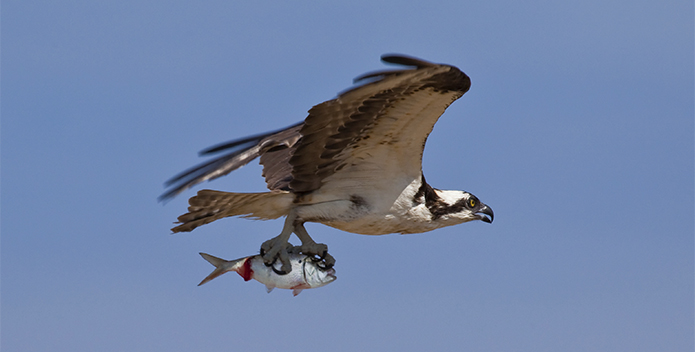The 2023 Osprey research season in Mobjack Bay, a sub-estuary of the Chesapeake Bay, began as others had for decades. Cruising the brackish waters in a small motorboat, Bryan Watts, director of William & Mary’s Center for Conservation Biology in Virginia, and Michael Academia, a researcher at the center, eased up to nesting platforms, boat houses, and abandoned docks dotting the shoreline. Lifting mirrors on long poles, they held them over elevated Osprey nests and used the reflections to peer inside.
What the researchers saw in those mirrors—or, rather, what they didn’t see—was disturbing: Out of 167 nests they visited in Mobjack Bay and two nearby rivers, only 17 held live chicks. “It was a catastrophic failure,” says Watts, who has studied Ospreys in the area for decades.
The Chesapeake Bay supports the largest Osprey population in the world: 10,000 to 12,000 breeding pairs of the only raptor that dives talons-first into the water to collect a meal. William & Mary scientists have studied these birds since just before the 1972 ban on DDT, an insecticide that caused most nests to fail. After the ban, hatching rates and Osprey populations rebounded. But in recent years, productivity in some areas has declined sharply again. Last year, reproductive rates dropped to their lowest level in decades—even lower than at the height of the DDT period, Watts says.
This time, researchers say the cause is not chemicals but hunger. Chicks are starving in their nests due to a lack of prey, and in particular, the small, high-fat forage fish on which some Osprey depend: Atlantic menhaden. “There’s no question that there’s not enough menhaden to support the Osprey right now,” Watts says. In the Chesapeake, conservationists say those menhaden declines are due to overfishing by a single company, and are increasingly vocal in urging regulators to take action.
No data exist for the number of menhaden in the Chesapeake, so scientists look to the birds as indicators of how healthy stocks are. While Ospreys eat a wide variety of fish, they need a certain amount of high-fat menhaden to survive, Watts says. He and Academia first assessed the relationship between Ospreys and food availability in 2021, comparing outcomes for pairs that received supplemental menhaden and pairs that didn’t. Among the latter group, the number of live young was well below what would sustain the population. “Most of the nests failed within the first two weeks of hatching, the critical part when they need the food,” Academia says.
In early 2024, William & Mary researchers published a study in Frontiers of Marine Science linking Osprey declines since the 1980s to declines in menhaden during that time. The study suggested that menhaden stocks needed to be restored to 1980s levels to stabilize the Osprey population.
These results also brought the birds into the contentious matter of menhaden harvesting in the Chesapeake Bay. While scientists say it’s clear that Osprey aren’t getting enough menhaden, the role of commercial fishing remains a subject of fierce debate. The federal government sets the allowed harvest of menhaden, and the 16 participating states decide how to manage their quotas, with Virginia taking the lion’s share. In 2022, a federal regulator, the Atlantic States Marine Fisheries Commission, concluded there was no evidence that menhaden were being overfished along the Atlantic coast.
The local Ospreys are back, having settled back in in late March. It seems to my like there are less of them this year than in years past. Osprey are pretty adaptable, living world wide in suitable habitats. They don't "depend" on Menhaden, but certainly in the Chesapeake, Menhaden are by far the largest amount of prey available in the right size range, and they swim conveniently near the surface in summer. Certainly a major decrease in Menhaden biomass would require Ospreys to hunt farther afield, and longer, and would support a smaller population. I think it's pretty clear that the Menhaden fishery in the Bay has significantly decreased their abundance in the Bay.


No comments:
Post a Comment